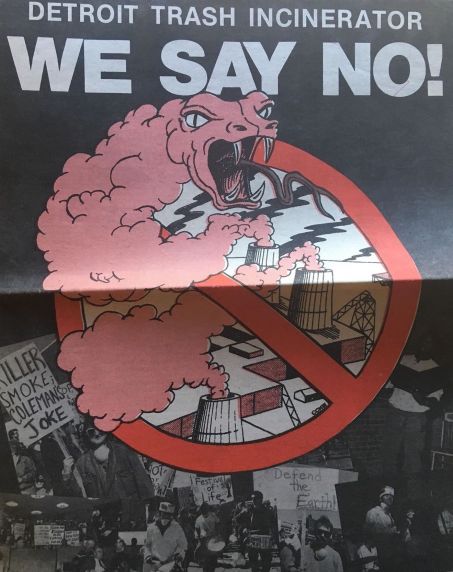Guest Post: Detroit Incinerator
Please note: The oral history course collections mentioned in this post have been consolidated into one collection: Wayne State University Oral History Methodology Course Oral Histories. Please refer to the finding aid here: https://archives.wayne.edu/repositories/2/resources/3381.
The history of the Detroit Incinerator, later rebranded as Detroit Renewable Power, is a microcosm of the history of intersections of environmental and social justice. The Reuther Library has many collections related to the community response surrounding the Incinerator’s building and operation. It was originally built in 1986 near the corner of Russell and East Ferry Street. Billed as the “world’s largest” trash incinerator, it was supposed to be a regional plant that would burn trash and convert it to energy for the city. The Incinerator’s construction was met with intense protest from a variety of environmental and community groups. Activists from the Evergreen Alliance, opposed to its building and continued use, recognized that communities were systematically sacrificed by the Incinerator. This exposed the racial and economic injustice of building polluting industries in communities that are home to people of color or economically disadvantaged populations. After operating for decades despite continued protest, the company that runs the Incinerator announced its closing as of the end of March 2019.
To better understand the history of the Incinerator and its opposition, check out the collections of the Reuther Library. One such collection is the Thomas W. Stephens Papers. Stephens was the founder of the Evergreen Alliance, the Michigan Environmental Justice Coalition and a chair of the National Lawyers’ Guild’s Toxics Committee. The Stephens Papers include a large number of documents pertaining to legal action against the City of Detroit and the Incinerator, along with evidence of environmental and community activism to fight it. The “Detroit Trash Incinerator We Say No” photograph is from the front page of a newspaper published in 1986 by The Evergreen Alliance. Found in box 3 of the Stephens Papers, the publication contains articles explaining the pollution caused by trash incineration and other environmental concerns of the time.
Stephens is one of four interviewees found in the Wayne State Oral History Course Oral Histories, 2014 collection located at the Reuther Library. In addition, three other environmental activists were interviewed and discuss their opposition and activism in response to the Incinerator’s building and its pollution. These interviewees include Anna Holden, Carol Izant, and Donele Wilkins. Holden was an active member of the Sierra Club, both in Detroit and at the State Chapter in Lansing, MI. The Sierra Club and other environmental organizations were part of a lawsuit brought against the city to prevent the Incinerator from being built. Holden details the cost of the Incinerator to the city, both financial and to the health of the people living nearby. Izant was arrested in 1989 while protesting at the gates of the Incinerator. She was involved in many activist organizations including Women Empowered Against Violence to the Environment.
In her interview, Izant identified the incinerator as “Coleman Young’s baby,” asserting that the mayor was deeply involved in the building, and public bolstering of the project. The Burton Historical Collection currently holds the Coleman A Young Papers during his time as mayor from 1972 until 1992. The Young Papers provide a different perspective than that of the environmental activists in that Young was a prominent supporter of the Incinerator Project. Spanning the years 1986 through 1992, look to boxes 233, 245, 258, 275, 289, 304, and 316 for materials on the Greater Detroit Resource Recovery Authority, which was the waste management company that operated the Incinerator.
This post was contributed by Ciera Casteel, a student in the Wayne State School of Information Science in Winter 2019.


 Reddit
Reddit Facebook
Facebook LinkedIn
LinkedIn